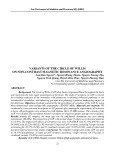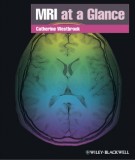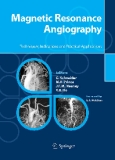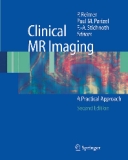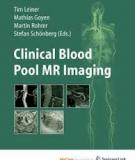
MR angiography
-
Evaluate and describe the prevalence of variations of the CoW by using three-dimensional time-of-flight MR angiography (3D-TOF-MRA). Materials and methods: We conducted a cross-sectional description in 102 patients after meeting the requirements of inclusion criteria. All participants were scanned in a GE Optima 360 1.5T MRI scanner.
 8p
8p  vistarlord
vistarlord
 24-06-2023
24-06-2023
 8
8
 3
3
 Download
Download
-
(bq) part 2 book "mri at a glance" presentation of content: data acquisition and scan time, signal to noise ratio, spatial resolution, magnetic susceptibility, flow phenomena, phase contrast mr angiography, phase contrast mr angiography, contrast enhanced mr angiography, screening and safety procedures,...
 63p
63p  thangnamvoiva23
thangnamvoiva23
 06-10-2016
06-10-2016
 33
33
 4
4
 Download
Download
-
(BQ) Continued part 1, part 2 of the document Diagnostic methods in the cardiac catheterization laboratory presents the following contents: Clinical applications of OCT, viability assessment and cardiac function, cardiovascular interventional MR imaging, coronary stenosis evaluation with CT angiography, invasive evaluation of renal artery stenosis,...
 155p
155p  thangnamvoiva4
thangnamvoiva4
 01-07-2016
01-07-2016
 63
63
 3
3
 Download
Download
-
The Sixth Edition of Dr. Haines's best-selling neuroanatomy atlas features a stronger clinical emphasis, with significantly expanded clinical information and correlations. More than 110 new images--including MRI, CT, MR angiography, color line drawings, and brain specimens--highlight anatomical-clinical correlations. Internal spinal cord and brainstem morphology are presented in a new format that shows images in both anatomical and clinical orientations, correlating this anatomy exactly with how the brain and its functional systems are viewed in the clinical setting.
 306p
306p  mientrung102
mientrung102
 30-01-2013
30-01-2013
 60
60
 9
9
 Download
Download
-
This book, like its conventional counterpart Normal Findings in Radiography, deals with the apparently banal subject of the normal. It addresses the question of how to recognize what is normal and how to describe normal findings. These questions are as important in computed tomography and magnetic resonance imaging as in other modalities. Even “sectional imaging” is based on the classical approach of reading images and formulating findingPetrous pyramids
 257p
257p  waduroi
waduroi
 03-11-2012
03-11-2012
 89
89
 11
11
 Download
Download
-
When I was asked to write this book, my first thought was how was I going to improve on what was already out there? There are literally dozens of enormous volumes covering the everexpanding field of MRI. This rather more concise effort attempts to pull together lots of vital information and condense it down into a simple-to-follow guide. It will be useful for trainees and experienced professionals alike.
 150p
150p  waduroi
waduroi
 03-11-2012
03-11-2012
 75
75
 11
11
 Download
Download
-
Those of us involved in the development of magnetic resonance angiography (MRA) in the late 1980’s could hardly envision the routine application of MRA in every MR facility everyday. In those years there was spectacular development of many new MR clinical applications.Many pioneering researchers investigated various strategies exploiting the effects of blood flow on the MR signal to optimize clinical MRA. Remarkable successes were demonstrated in rapid succession.
 366p
366p  echbuon
echbuon
 02-11-2012
02-11-2012
 44
44
 9
9
 Download
Download
-
Magnetic resonance (MR) imaging has become the leading cross-sectional imaging method in clinical practice. Since the 1980s, continuous improvements in hardware and software have significantly broadened the scope of applications. At present, MR imaging is not only the most important technique in neuroradiology and musculoskeletal radiology, but has also become an invaluable diagnostic tool for abdominal, pelvic, cardiac, breast and vascular imaging.
 611p
611p  echbuon
echbuon
 02-11-2012
02-11-2012
 70
70
 13
13
 Download
Download
-
The successful introduction of extracellular gadolinium-based contrast agents for contrastenhanced MR angiography, and their wide acceptance today, raise the question of what part an intravascular contrast agent might play in diagnostic imaging. The answer lies in the capacity of an intravascular agent to give us high-level diagnostic information from first pass arterial imaging and, at the same time, to yield additional diagnostic value by allowing delayed imaging from the same contrast injection.
 262p
262p  xunu1311
xunu1311
 02-11-2012
02-11-2012
 50
50
 3
3
 Download
Download
CHỦ ĐỀ BẠN MUỐN TÌM








